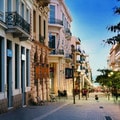Activities
Take full advantage of your stay in Heraklion
 Knossos Palace
Knossos Palace
6.2 km away
The Minoan palace is the main site of interest at Knossos, an important city in antiquity, which was inhabited continuously from the Neolithic period until the 5th c. AD. The palace (more)
 Church of St. Peter and Paul
Church of St. Peter and Paul
0.15 km away
The Church of Ss. Peter and Paul was built in the first years of Venetian rule as the katholikon in the Dominican order monastery (Domenicani Predicatori). It is one of the oldest (more)
 Cretaquarium
Cretaquarium
19.2 km away
The Cretaquarium project was conceived by employees of the former Institute of Marine Biology of Crete (IMBC) to create the first large aquarium in Greece, as part of a marine park (more)
 Venetian fortress of Koules
Venetian fortress of Koules
0.35 km away
The Venetian fortress of Koules dominates the entrance to the Venetian harbour of Heraklion. The Venetians called it the “Sea Fortress” (Castello a Mare or Rocca a Mare), but today (more)
 25th August Street
25th August Street
0.29 km away
25th of August Street runs from the Meidani, the central crossroads of Heraklion, down to the Venetian harbour and the fortress of Koules. Along it are the Basilica of St Mark, the (more)
 Nikos Kazantzakis Grave
Nikos Kazantzakis Grave
1.2 km away
The grave of the important Cretan writer Nikos Kazantzakis (1883-1957) is located at the highest point of the Walls of Heraklion, the Martinengo Bastion, with panoramic views to the (more)
- less than a minute






